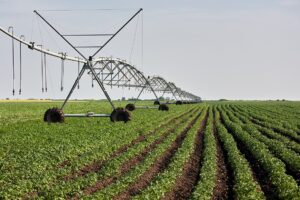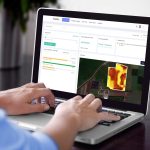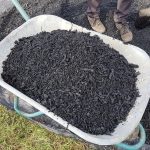Principles of irrigation systems design
Designing an irrigation system requires knowledge of the crop, field conditions, soil and water. Answering the following questions can help in determining the characteristics of the irrigation system.
- What is the soil texture? How much water can the soil retain?
- What is the size of the field?
- What is the topography of the field?
- Will the field be divided to irrigation sections?
- What is the planting density of the crop?
- What is the depth of the crop’s root system?
- What are the water requirements of the crop in its specific location?
- What is the source of water supply? What is the water quality?
- What is are the costs and labor requirements of the system?
TYPES OF IRRIGATION SYSTEMS
The main three types of irrigation systems are surface irrigation, overhead irrigation and localized irrigation.
Surface irrigation refers to irrigation systems that deliver water across the field by gravity. The system is designed in such a way that water flows from a water supply ditch at the upper end of the field to the lower end of the field and infiltrates into the soil as it advances.
Surface irrigation has a high labor requirement, and, of all irrigation methods, surface irrigation has the lowest water use efficiency (around 55%). It is not suitable for sandy soils due to their high infiltration rate.
Surface irrigation methods include furrow irrigation, border irrigation and flood irrigation. Furrow irrigation is more suitable for row crops where only part of the field surface is irrigated. Border irrigation is appropriate for most crops, except crops that require flooding conditions, such as rice.
Overhead irrigation refers to permanent sprinkler irrigation and pivot irrigation. This method has higher efficiency compared to surface irrigation. However, the initial investments costs are high.
Localized irrigation is the most efficient of all methods and has a water use efficiency of 90% and higher. However, it is most suited for smaller areas, requires good water quality and has a high initial and maintenance costs.
Localized irrigation includes drip irrigation, sub-drip irrigation systems and micro-sprinklers.
The following table compares irrigation system types:
| Surface irrigation | Overhead irrigation | Localized irrigation | |
|---|---|---|---|
| Soil types | All, except sandy soils | All | All |
| Water availability | Suited to areas with very high water availability | Suited to areas with very high water availability | Suited to areas with limited water availability |
| Water quality | Can work with water with high sediment content | Relatively low salt concentration is required | Low salt content is required. |
| Climate | Any | Areas with strong winds should be avoided | Any |
| Automation | Less common | Very common | Very common |
| Fertilization | Not suitable for fertigation | Suitable for fertigation. Fertilizer losses may occur. | Suitable for fertigation. High efficiency. |
| Operational flexibility | Low | High | High |
IRRIGATION FLOW RATE
Refers to the rate of water application in overhead and localized irrigation. The irrigation flow rate is expressed in units of m3/hr or gallons/min.
In order to minimize soil erosion and runoff, the irrigation flow rate should be planned in such a way that it does not exceed the soil infiltration rate.
The minimum required irrigation flow rate:
Q = A x D x F / t
Where:
A Field area
D Maximum water requirement of the crop (maximum ETc of the crop in mm)
t Time available for irrigation per day (hours)
F=10 when An is in hectares, Dn in millimeters and Q in m3/hr.
F=452.57 when An is in acres, Dn in inches and Q in gal/min.
For example:
The area of the field is 8 hectares (20 acres), maximum crop evapotranspiration 7 mm/day (0.27 inches) and grower can irrigate maximum 14 hours per day. Thus, the minimum required irrigation flow rate
Q = 8x7x10/14 = 40 m3/hr
or
20×0.27×452.57 /14 = 174.5 gal/min.
IRRIGATION DURATION
An important parameter to know and consider at the design phase is the required irrigation duration. It can be calculated using the soil properties, the efficiency of the irrigation system and the leaching requirement (which is a function of water quality and salt tolerance of the crop).
t = RAW / I (1-LR) e
Where
RAW – Readily available water
I – Soil infiltration rate
LR – Leaching Requirement
e – Irrigation efficiency (fraction)
IRRIGATION UNIFORMITY
A uniformity of 100% means that each point within the irrigated area receives the same amount of irrigation.
Several indices are used to evaluate irrigation uniformity in different irrigation systems:
DU – Distribution uniformity – used for localized irrigation and sprinkler irrigation.
CU – Christiansen uniformity coefficient – used for sprinkler irrigation.
Distribution Uniformity (DU)
DU = 100 x (Q25% / Qn)
Where
Q25% Average flow rate of 25% of the emitters with the lowest flow rate.
Qn Average flow rate of all emitters.
| DU (%) | Classification |
| 95-100 | Excellent |
| 85-95 | Good |
| 75-85 | Regular |
| 65-75 | Poor |
| <60 | Unacceptable |
To calculate the DU, between 40 and 100 emitters, from different sections of the field, must be randomly sampled.
Christiansen’s Uniformity Coefficient (CU)
CU is commonly used for sprinkler irrigation systems.
CU = 100 X (1 – (∑|Di – DAve| / nDAve)
Where
Di Amount of water in an individual water catch can
DAve Average amount of water in all catch cans
n number of catch cans
CU for sprinkler irrigation:
| CU (%) | Classification |
| <70 | Poor |
| 70-90 | Adequate |
| >90 | Excellent |









